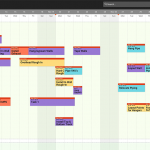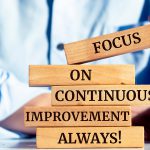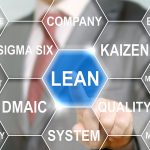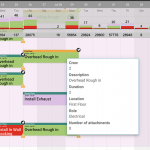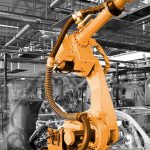I caught up with Lean consultant Hal Macomber and the Director of Regen50 in Johannesburg, South Africa, Calayde Davey, while they were at LCI Congress 2018. We discussed what’s changed since they co-authored The Pocket Sensei, Mastering Lean Leadership in 2017, how Kaizen practices can be introduced to design as well as construction, and what they plan to cover in the book’s upcoming second volume. Our conversation has been lightly edited.
Katherine Van Adzin: Welcome! Our readers are familiar with Hal, but I’d like to get a quick introduction to you, Calayde.
Calayde Davey: My background is in architecture, construction and development. I’m now home-based in South Africa where I’m running an urban strategies company. We do very interesting work. We focus on unlocking catalytic projects and then bringing people together to make it happen. The South African company is called Regen50. It means regenerative development within people and places, 50,000 people at a time. I’m also in partnership with Hal in the Lean world, bringing Lean practices and development to projects and enterprises in the built environment. One large initiative we are launching in 2018 is Lean Africa—we are building up the partnerships to introduce and develop Lean practices across the entire value-chain of built environment project delivery in African states.
Hal Macomber: And she’s been back in South Africa a year after spending five years in the States, three getting her PhD and two getting some relevant design, construction and development experience. She was working for my client as the Lean leader on a Lean IPD job, and it was a Touchplan job.
KV: And then you co-authored Pocket Sensei?
HM: That’s right. The next big thing that we’re working on is volume two. It is about Kaizen and that’s what we want to talk about today. Lean is built on two bedrock principles: respect for people and continuous improvement. If you look at what’s going on in design and construction in the Lean community we’re getting pretty good at the respect for people part. More and more people are a part of the planning and engagement—engagement in their work and then with each other.
There’s a wonderful change that’s happened on the most successful projects; tradespeople are treating other tradespeople (like plumbers are treating carpenters) as their customers now. And that’s never happened before, but it’s happening now. We’re getting wonderfully better projects, more frequently. The Last Planner® System counts on that customer mindset and it enables that.
However, the other bedrock principle, continuous improvement, isn’t happening in our industry. While people might be offended by me saying that, it needs to be said. Continuous means continuous.
CD: All the time.
HM: Yes, it means that all the time, everyone is making their work situation better, and that usually means how they do what they do, but it also means people deliberately improving themselves. We’re getting episodic improvements—maybe at the end of a phase of work, when we hit a milestone. Let’s say the first milestone is building foundation and all the utilities that are underground. That sort of thing. That’s a big milestone. Good teams will stop and they’ll do a retrospective, and out of that retrospection will come some plans for making change of some sort. But it could be four months of work before something significant like that happens.
CD: Also, in four months of change occurring, the same people who’ve made the changes may not be there to learn about the improved process, activity or thing.
HM: That’s also true.
CD: If we take so long to learn something, not everyone is necessarily learning about it. We have to relearn. Because we always have to relearn, we make or repeat mistakes somewhere else.
HM: Think about all the different changes that we made in staffing. Somebody’s been excavating and then they’re now onto excavating someplace else, and we weren’t managing the project for continuous improvement. So, we aren’t getting continuous improvement. We’re only getting the episodic improvement perhaps at the end, if we remember to do it. And the key people who participated in getting us to a finished foundation with utilities may not be around anymore. They could be long gone.
CD: I know we’re speaking in the negative but sometimes you forget what you did that you improved. Memory is a big deal. You might make an intuitive improvement, suddenly forget about it, and not be able to speak about it.
HM: Yes, if you don’t write it down, if you don’t share it, it didn’t happen. I don’t mean that existentially it didn’t happen, because it did happen existentially. But it didn’t happen that it could be replicated or built on or even remembered.
CD: I see this in design decision making. A team could, by luck, develop a good design—not necessarily by intent. Often what happens is they rely on that luck or talent or intuition for the next one, as opposed to understanding the things that led to that good design. They can’t remember what they did that was innovative, and now they have to relearn the innovation on the next project, redoing the innovative prompting.
HM: Let’s talk about that for a minute. In the discourse of architecture, or the discourse of engineering, there’s no practice that students are introduced to that is Kaizen, or continuously improving on what they are doing. While there is project work in a design studio, they’re mostly working on their own skills and not the collaborative work of design. And they never get to the Kaizen activities that you would do.
CD: Then they go into the profession where improvement is expected, but they’re not involved in habits that underscore, “How do we invent and create and continuously do that logically—and how can everyone learn from this together?” There is a crisis there.
HM: So we get the same boring design—
CD: The same flawed designs—
HM: —flawed design but functioning design, over and over again.
CD: On the design of Lean delivery, this is a fatal flaw. Now when we translate a design to construction, suddenly the construction side is expected to be the continuously improving partner. But design isn’t. And that’s strange. Why is that so? It’s really strange. Then we put them all in an IPD group to seek out design improvements, but we don’t teach the designers to improve. Kaizen should be present really early on, and it’s not.
HM: I used the term “discourse.” With discourse, we don’t mean simply an extended conversation, you could call what we’re doing right now discourse, an extended conversation about a topic. I’m talking about something much bigger. It’s the bringing together of people, education, practices, institutions, and laws that are all associated with a profession.
CD: Or a shared, common set of practices with an ideology or philosophy guiding the practices.
HM: Yes, it doesn’t have to be a profession. I’m thinking for example, shoeing a horse is a whole set of practices, tools, and ways to learn how to do it. A way to find people who can shoe a horse and you can say that only lives in the discourse of taking care of horses, raising horses and all that sort of stuff.
We have well-defined discourses of architecture. There are schools, institutions, licensing boards, magazines, there’s a way to enter architecture as a profession.
CD: Or to migrate to it.
HM: There are ways to migrate to it, there’s a way to stay current in the profession, with continued education.
CD: And a history.
HM: Yes, there’s a long history. We talk about it and we build on it. And we actually revisit it in our design. The same is true for civil engineering, the same is true for medicine, and so on. Yet, within the discourses, there’s nothing like Kaizen. It doesn’t exist. People learn to behave as a civil engineer without something called continuous improvement of the craft, continuous improvement of the practice of engineering.
CD: Instead, in our professions we are continuously exposed to new things through our licensing and institutions. But exposure to new things is not the same as a practice of continuous improvement.
HM: Yeah, eventually we do it often enough that we get better, or learn about a new thing, but we’re not shifting the craft forward. We’re not shifting the discipline or the practice. Kaizen doesn’t exist right now in design. Kaizen doesn’t exist, fundamentally, in construction either.
CD: In the arts it does. In the arts, in the music arts, in ballet or in sculpture or any artistic expression, it’s expected in the discourse of art to improve and change the discourse. It’s built into the history of art, especially modern art but also the older arts. Your job as artists is to change the discourse. It’s expected. Your identity as an artist is built on that core thing. That, if you were asking Andy Warhol why he’s Andy Warhol, then he would likely respond and say, “I want to change art.” We don’t do that in our world. We don’t say we want to change architecture for the better, make it a little bit different. But the world of art does that, because the discourse of art includes the challenge to change and improve the discourse for the better.
HM: Yes, it’s part of the way of working.
CD: It’s expected.
HM: But continuous improvement isn’t expected in the disciplines of the built environment.
CD: Exactly.
HM: Continuous improvement does exist in the practice of Lean manufacturing. It’s in there; we can measure it. The industry has said that a high-performing Lean manufacturing environment produces two adopted improvements per person, per month. That’s a high-performing Lean manufacturing environment. Now it turns out that you can get much better at that. One of your customers is J.C. Cannistraro, they use Touchplan, and they were recognized recently as a high-performing improvement system using the software Kainexus. They were getting about two adopted improvements per person, per month, during that period of time.
An organization like Toyota in the Georgetown, Kentucky plant is getting about one improvement per person, per week. And at Subaru, in Lafayette, Indiana, they’re getting over 115 adopted improvements per person, per year. We aren’t getting 115 adopted improvements out of 500 people on a project in a two-year period, let’s say. We’re getting some episode-based improvement, we’re doing plus/deltas on the projects that are really good at Lean, they’re getting plus/deltas on all their weekly meetings, but fundamentally in our discourse we’re missing the practices of continuously improving.
CD: I was thinking now about a conversation yesterday. We were talking in a large room about the world culture and Lean practices. In that conversation Hal said, “There are two ways that Lean can be explained within different world cultures.” One was, Lean is a human development mechanism that masquerades as an operational strategy. And the inverse of that was that Lean is an operations strategy that requires people to improve.
HM: Yeah, operating strategy that relies on people improving. Is “improvement” what we’re working on, or is improvement the byproduct of what we’re working on?
CD: To change and improve yourselves is the thing you should be emphasizing first.
HM: Right. Toyota said that improving oneself is the principal act that they’re taking. They do it by making improvements to their work. It’s like the practice area. You’re making improvements at work, that’s the practice that builds your critical thinking, creative thinking and ability to make change. So we’re doing it for the sake of building our skill, and we’re just getting practice by making improvement in whatever it is.
Ironically, when you look at where we are as an industry—I don’t know who first said this, it wasn’t me—we have the tyranny of low expectations of the workforce. We just hope they’ll do what we want them to do, because way too often they don’t. We never have the expectation that we could have two adopted improvements out of everybody, every month. J.C. Cannistraro made that happen. So we just don’t have a high enough expectation of other human beings to bring that forth into work. And therefore, we’re not showing respect. We’re not respecting the humanity of our situation.
CD: And that’s what the new book is about.
HM: We’re addressing it head on. We’re addressing what needs to change, how to make the change and how to learn to continue learning in the same way that the Katas in the first book were providing practices for making that change and bringing leadership to those around you.
CD: The new book has much more meat about the “why.” Much, much more. The book is going to be similar to the style of the first—providing direct ways of how to do things and build the right habits—but it is much more sophisticated in the purpose and the understanding of why we’re doing it.
HM: It’s interesting that generally in the automotive industry they’re getting somewhere between three and five adopted improvements per person, per year. But that’s an industry-wide average. And it’s high because Toyota’s getting fifty, and Subaru’s getting 115, and there are two other firms that are getting over 100 adopted improvements per person, per year. There are these out-performers that are raising the average all the way up to something like five, industry-wide. But when you look at the general situation in automotive industries and practices, it’s something around three. It’s two or three. It could be zero in some plants, or really close to zero. And that’s an industry that’s actually trying Kaizen.
CD: Kaizen is actually part of their discourse.
HM: Yes, it is part of their discourse. You can’t make cars today without the Lean practices of manufacturing. But you can, using experts, produce that situation. But Toyota doesn’t do it that way, Toyota uses everybody to produce that situation. They rely on 100 percent of their workforce to create the Lean practices of building cars. And they use the same employees. There’s the story of Toyota coming to the US in partnership with General Motors: They took a shuttered GM factory in Fremont, California, and that one facility had more outstanding grievances than the rest of the company combined. Toyota came in and they said, “Okay, how are we going to do this?” And GM said, “Well, we had great managers, and we know we had great managers because we could get cars out the door.” Because they really had all these recalcitrant people, and they were doing damage. Toyota checked things out and they said, “We’re going to hire all the workers back but none of the managers.”
Fourteen months after that they started making Corollas—that’s all they made in that factory when they started—and fourteen months later the quality was indistinguishable from Corollas made anywhere else in the world. Indistinguishable. And made by the same previously recalcitrant people. So we know it’s not about the people.
CD: It is not about the ability of people.
HM: Yes, it’s not about the ability of people. It’s about how we go about our leadership and our practices of managing.
CD: And managing our expectations. When I was a young girl and I was considering different careers, I had an image in my mind of what a laboratory looked like. A scientist is someone who acts like a scientist. They invent and they’re doing and they’re learning and they’re always changing, and that’s what you do if you want to be a scientist. I’m speaking like a child. So the picture in my mind, I thought, was that if I want to grow up and want to be a scientist I know that scientists invent. Scientists constantly change and make things better. It’s part of the discourse of science—who scientists are, and what scientists do—is moving science forward for the sake of the betterment of the world. And science labs are cool.
If someone said to me as a young person, “You’re going to become a car designer,” I already had that picture in mind, that the work of designing a car includes experimenting with robots and iterations. And that all new cars will be different and better—it is expected. My expectations of what a car designer would do already included that they are good at continuously inventing and improving.
When I thought of architecture, I had a different image in my mind and it didn’t include those things. It included a different picture of the architect, and that picture didn’t include improving. We don’t have a clear picture of what it looks like in the fantastical mind of construction. And the romance of the idea of the scientist or inventor, we don’t have that story for construction and design, so how do we go about inserting some of that narrative into our built environment discourses as well?
HM: Right, that conversation is not happening. Let’s go back to construction and the Last Planner® situation. All of my clients’ projects are on Touchplan, because I insist they use software to support the effective use of the Last Planner System®. One of the reasons behind that is that I want them changing things every day. They can learn every day, I want them to change every day, and the only way they can do that is with software. There’s no other way to do this in a coherent way and have a new plan show up for everybody who’s impacted without meetings and all kinds of administrative work.
What we do with our clients is that every afternoon they come to a meeting. It’s foremen meeting with each other as customers (plumbing customers, framing customers, drywall customers, etc.) We have them talk to their customers about how they did that day. Did they keep their promises? Did they get the work done that they promised to do? And it’s yes or no, and if it’s no, they talk about what they’re going to change so that they can keep their promises. That’s the first improvement act that we build into their daily routine. And then we follow it with a high expectation.
We ask them, “What did you learn today? What did you improve today?” And, “What will make tomorrow go better?” And in a group of five or so foremen (because you might have twenty foremen on a job) you’ll have a handful of foremen whose work is related to each other on a day-to-day basis. In that size group, there should be at least one positive answer to, “We learned this, we’ve improved that, we could use something better tomorrow.” And our clients are getting that kind of result. Companies like Cianbro, Granger, Joeris and BOND are all doing that practice. And it shows. They don’t get stuck at seventy percent PPC. Their PPC, percent of promises completed, continues to rise well into the high eighties, sometimes into the low nineties. It keeps rising and rising on their projects.
CD: And the PPC remains more stable.
HM: The reliability goes up, yes. It continues to rise, as opposed to high fluctuation around an average of about seventy percent. So we know we can get continuous improvement because we are getting it. We’re getting it because we’re asking for it. We inject the daily practice of reflecting on learning, improving and taking better care of tomorrow. We inject that into the practice. People are going to continuously learn and improve and they like it. We can bring that as an expectation and we can set ourselves up to manage that way and have the practice for managing that way. It’s in that way we’re changing the discourse of Lean construction. It now includes the possibility and expectation of Kaizen.
For more Lean learning, register for our webinar on Milestone and Phase Planning!

